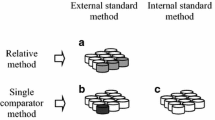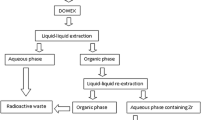Abstract
Two samples of zircon concentrate by local manufacturers were investigated for the first time for their rare earth elements (REE) content by instrumental neutron activation analysis (INAA) and energy dispersive X-ray fluorescence analysis. Comparator variant of INAA based on an external standard (Fe) and two internal standards (Th, La) was used to determine the elements divided into three groups depending on the detector type, radionuclide half-lives, and suitable comparator.
High Y and heavy REE contents of the samples exceeding their crustal averages up to two orders of magnitude confirmed significance of the zircon concentrate as an important source of these elements production as a by-product.




Similar content being viewed by others
References
Dushyantha N, Batapola N, Ilankoon IMSK et al (2020) The story of rare earth elements (REEs): occurrences, global distribution, genesis, geology, mineralogy and global production. Ore Geol Rev. https://doi.org/10.1016/j.oregeorev.2020.103521
Balaram V (2019) Rare earth elements—a review of applications, occurrence, exploration, analysis, recycling, and environmental impact. Geosci Front 10:1285–1303
Zhou B, Li Z, Chen C (2017) Global potential of rare earth resources and rare earth demand from clean technologies. Minerals. https://doi.org/10.3390/min7110203
Costis S, Mueller KK, Coudert L et al (2021) Recovery potential of rare earth elements from mining and industrial residues—a review and cases studies. J Geochem Explor. https://doi.org/10.1016/j.gexplo.2020.106699
Zhang W, Noble A, Yang X et al (2020) A comprehensive review of rare earth elements recovery from coal-related materials. Minerals. https://doi.org/10.3390/min10050451
Rychkov VN, Kirillov EV, Kirillov SV et al (2018) Recovery of rare earth elements from phosphogypsum. J Cleaner Prod 196:674–681
Peiravi M, Dehghani F, Ackah L et al (2021) A review of rare-earth elements extraction with emphasis on non-conventional sources: Coal and coal byproducts, iron ore tailings, apatite, and phosphate byproducts. Min, Metall Explor 38(1):1–26
Alves FE, Neumann R, Ávila CA et al (2021) Mineralogical auditing of the volta grande mine (SE Brazil) Sn–Ta–Nb–Li processing plant, aiming at REE recovery as by-products. Appl Earth Sci 130:198–208
Dehaine Q, Filippov LO, Joussemet R (2017) Rare earths (La, Ce, Nd) and rare metals (Sn, Nb, W) as by-products of kaolin production – Part 2: Gravity processing of micaceous residues. Miner Eng 100:200–210
Paulick H, Machacek E (2017) The global rare earth element exploration boom: an analysis of resources outside of China and discussion of development perspectives. Resour Policy 52:134–153
Makeyev AB, Skublov SG (2016) Y-REE-rich zircons of the Timan region: geochemistry and economic significance. Geochem Int 54(9):788–794
Trisnawati I, Prameswara G, Mulyono P et al (2020) Sulfuric acid leaching of heavy rare earth elements (HREEs) from Indonesian zircon tailing. Int J Technol 11(4):804–816
Handini T (2020) Separation the zircon mineral from tailing tin mining using shaking table. J Phys Conf Ser. https://doi.org/10.1088/1742-6596/1436/1/012127
Singh A, Padmasubashini V, Gopal L (2012) Determination of uranium, thorium and rare-earth elements in zircon samples using ICP-MS. J Radioanal Nucl Chem 294:19–25
Krishnakumar M, Chakrapani G, Satyanarayana K et al (2016) Selective matrix removal and ICP-OES determination of trace uranium, rare earth elements and yttrium in zircon minerals. J Radioanal Nucl Chem 307:497–505
Zhang J, Wang L, Jiang D (2012) Decomposition process of zircon sand concentrate with CaO–NaOH. Rare Met 31(4):410–414
Thibault Y, Gamage McEvoy J, Duguay D (2020) Optimizing Zr and REE recovery from zircon through a better understanding of the mechanisms governing its decomposition in alkali media. In: Azimi G (ed) Rare metal technology. Springer, Cham
Zuma MC, Lakkakula J, Mketo N (2022) Recent trends in sample preparation methods and plasma-based spectrometric techniques for the determination of rare earth elements in geological and fossil fuel samples. Appl Spectrosc Rev 57:353–377
Zhang W, Hu Z (2019) Recent advances in sample preparation methods for elemental and isotopic analysis of geological samples. Spectroch Acta, Part B. https://doi.org/10.1016/j.sab.2019.105690
Tamura A, Akizawa N, Otsuka R et al (2015) Measurement of whole-rock trace-element composition by flux-free fused glass and LA-ICP-MS: evaluation of simple and rapid routine work. Geochem J 49:243–258
Lin J, Liu Y, Yang Y et al (2016) Calibration and correction of LA-ICP-MS and LA-MC-ICP-MS analyses for element contents and isotopic ratios. Solid Earth Sci 1:5–27
Karivai A, Zuzaan P, Gustova V (2011) A method for the determination of some rare earth elements and their correlation with thorium using X-ray fluorescence. Phys Part Nucl Lett 6(8):576–580
Siyanbola WO, Fasasi AY, Funtua II et al (2005) Energy dispersive X-ray fluorescence analysis of samples of the Nigerian zircons. Nucl Instrum Methods Phys Res, Sect B 239:426–432
Schramm R (2016) Use of X-ray fluorescence analysis for the determination of rare earth elements. Phys Sci Rev. https://doi.org/10.1515/psr-2016-0061
Smoliński A, Stempin M, Howaniec N (2016) Determination of rare earth elements in combustion ashes from selected Polish coal mines by wavelength dispersive X-ray fluorescence spectrometry. Spectroch Acta, Part B 116:63–74
Stosch H-G (2016) Neutron activation analysis of the rare earth elements (REE) – with emphasis on geological materials. Phys Sci Rev. https://doi.org/10.1515/psr-2016-0062
Attallah MF, Hilal MA, Moussa SI (2017) Quantification of some elements of nuclear and industrial interest from zircon mineral using neutron activation analysis and passive gamma-ray spectroscopy. Appl Radiat Isot 128:224–230
Silachyov IYu (2020) Neutron activation analysis of rare earth raw material using a planar detector and thorium as an internal standard. Int J Biol Chem 13:117–129
Silachyov I (2016) Rare earths analysis of rock samples by instrumental neutron activation analysis, internal standard method. J Radioanal Nucl Chem 310:573–582
K0-Neutron activation analysis link page. The NDC k0-databaze 2019. http://www.kayzero.com/k0naa/k0naaorg/Links.html. Accessed 15 Feb 2023
Simonov YA, Kritskii AA, Tomashov VA et al (2009) Study of the process of MgO regeneration from products of its sintering with zircon. Russ J Non-ferrous Metals 50(5):457–460
Koltochnik SN, Sairanbayev DS, Chekushina LV et al (2018) Comparison of neutron spectrum in the WWR-K reactor with LEU fuel against HEU one. NNC RK Bulletin 76(4):14–17 ((in Russian))
Silachyov IYu (2021) Determination of indium in its ore resources by comparator neutron activation analysis. Int J Biol Chem 14:106–116
Silachyov I (2020) Elemental analysis of vegetation samples by INAA internal standard method. J Radioanal Nucl Chem 324:97–108
Hamidatou L, Slamene H, Akhal T, Zouranen B (2013) Concepts, instrumentation and techniques of neutron activation analysis. In: Kharfi F (ed) Imaging and radioanalytical techniques in interdisciplinary research – fundamentals and cutting edge applications. InTech, Rijeka Croatia
Shirai N, Hidaka Y, Yamaguchi A et al (2015) Neutron activation analysis of iron meteorites. J Radioanal Nucl Chem 303:1375–1380
Diaz O, Figueiredo A, Nogueira C et al (2005) Epithermal neutron flux characterization of the IEA-R1 research reactor, Sao Paulo, Brazil. J Radioanal Nucl Chem 266:153–157
ISO 13528:2022 (2022) Statistical methods for use in proficiency testing by interlaboratory comparisons. International organization for standardization, Genève, Switzerland
Gusev S, Ryabev V, Vorobyov V et al (2004) OST 41–08–212–04 Industrial standard quality management of analytical work. Error guidelines for chemical analysis of mineral resources and precision classification of laboratory analytical techniques. Published by FSMC VIMS, Moscow ((in Russian))
Silachyov IYu (2018) Determination of rare earths in uranium raw material by neutron activation analysis and X-ray fluorescence. News Acad Sci RK, Ser Chem Technol 429(3):28–38
Rudnick RL, Gao S (2014) Composition of the continental crust. In: Holland HD, Turekian KK (eds) Treatise on geochemistry, vol 4, 2nd edn. Elsevier, College Park
Acknowledgements
This work was supported by the grant № BR05236400 from Ministry of Education and Sciences of the Republic of Kazakhstan.
Funding
Ministry of Education and Science of the Republic of Kazakhstan, BR05236400.
Author information
Authors and Affiliations
Corresponding author
Additional information
Publisher's Note
Springer Nature remains neutral with regard to jurisdictional claims in published maps and institutional affiliations.
Rights and permissions
Springer Nature or its licensor (e.g. a society or other partner) holds exclusive rights to this article under a publishing agreement with the author(s) or other rightsholder(s); author self-archiving of the accepted manuscript version of this article is solely governed by the terms of such publishing agreement and applicable law.
About this article
Cite this article
Silachyov, I. Zircon concentrate analysis for sixteen rare earth elements by the complex of nuclear analytical methods. J Radioanal Nucl Chem 332, 2017–2026 (2023). https://doi.org/10.1007/s10967-023-08844-1
Received:
Accepted:
Published:
Issue Date:
DOI: https://doi.org/10.1007/s10967-023-08844-1




